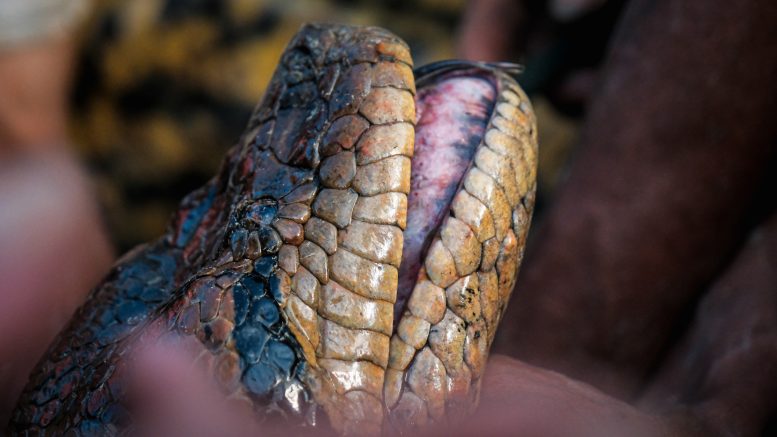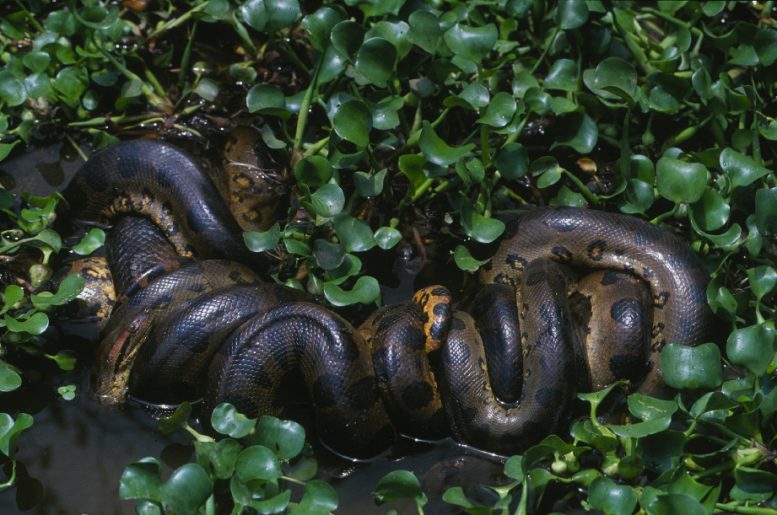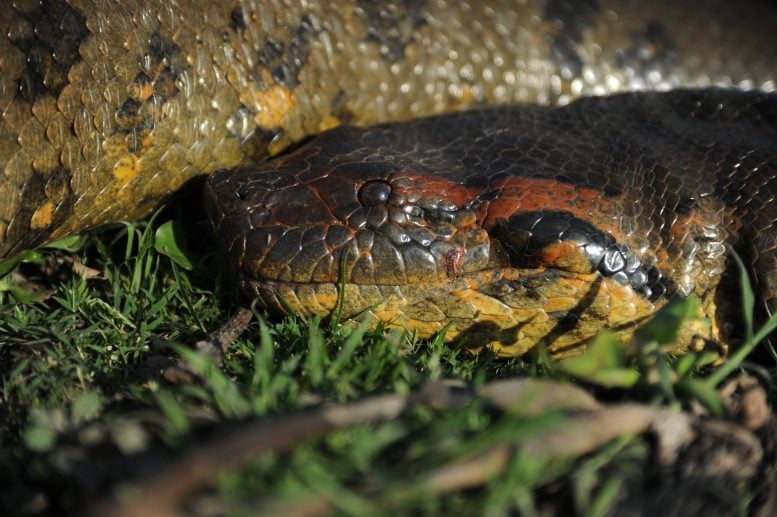“An Astounding 20 Feet Long”– Scientists Discover New Species of Giant Snake in the Remote Amazon
Scientists have discovered a new species of giant anaconda, the northern green anaconda, in the Ecuadorian Amazon. The discovery was made during an expedition invited by the Waorani people. The team’s findings highlight the genetic uniqueness of the species and the ecological threats facing the Amazon, underscoring the urgent need for conservation efforts. Credit: Jesus Rivas
A team of scientists on location with a film crew in the remote Amazon has uncovered a previously undocumented species of giant anaconda.
Professor Bryan Fry from The University of Queensland led a team which captured and studied several specimens of the newly named northern green anaconda (Eunectes akayima), located in the Bameno region of Baihuaeri Waorani Territory in the Ecuadorian Amazon.
“Our team received a rare invitation from the Waorani people to explore the region and collect samples from a population of anacondas, rumored to be the largest in existence,” Professor Fry said. “The indigenous hunters took us into the jungle on a 10-day expedition to search for these snakes, which they consider sacred. We paddled canoes down the river system and were lucky enough to find several anacondas lurking in the shallows, lying in wait for prey. The size of these magnificent creatures was incredible – one female anaconda we encountered measured an astounding 6.3 meters (20.7 feet) long. There are anecdotal reports from the Waorani people of other anacondas in the area measuring more than 7.5 meters (24.6 feet) long and weighing around 500 kilograms (1100 lbs).”

A northern green anaconda. Credit: Bryan Fry
Professor Fry said the northern green anaconda species diverged from the southern green anaconda almost 10 million years ago, and they differ genetically by 5.5 percent.
“It’s quite significant – to put it in perspective, humans differ from chimpanzees by only about 2 percent,” he said. “This discovery is the highlight of my career.”
Collaboration and Conservation Concerns
The new anaconda species was found while filming with National Geographic for their upcoming Disney+ series Pole to Pole with Will Smith, on which Professor Fry, a National Geographic Explorer, was the expedition’s scientific leader.
“Our journey into the heart of the Amazon, facilitated by the invitation of Waorani Chief Penti Baihua, was a true cross-cultural endeavor,” he said. “The importance of our Waorani collaborators is recognized with them being co-authors on the paper.”

A Eunectes akayima breeding ball. Credit: Jesus Rivas
The scientists also set out to compare the genetics of the green anaconda with specimens collected elsewhere by world-leading anaconda expert Dr Jesus Rivas from New Mexico Highlands University, and use them as an indicator species for ecosystem health.
Professor Fry said the Amazon continues to face alarming ecological threats.
“Deforestation of the Amazon basin from agricultural expansion has resulted in an estimated 20-31 percent habitat loss, which may impact up to 40 percent of its forests by 2050,” he said. “Another increasing problem is habitat degradation from land fragmentation, led by industrialized agriculture and heavy metal pollution associated with spills from oil extraction activities. Forest fires, drought, and climate change are also notable threats. These rare anacondas, and the other species that share this remote ecosystem, face significant challenges.”
Professor Fry said his next research project would focus on heavy metal pollution in the Amazon.
“It’s not only these gigantic snakes that are facing environmental threats, but almost all living things in the region,” he said. “The discovery of a new species of anaconda is exciting, but it is critical to highlight the urgent need to further research these threatened species and ecosystems.
Of particular urgency is research into how petrochemicals from oil spills are affecting the fertility and reproductive biology of these rare snakes and other keystone species in the Amazon.”
Reference: “Disentangling the Anacondas: Revealing a New Green Species and Rethinking Yellows” by Jesús A. Rivas, Paola De La Quintana, Marco Mancuso, Luis F. Pacheco, Gilson A. Rivas, Sandra Mariotto, David Salazar-Valenzuela, Marcelo Tepeña Baihua, Penti Baihua, Gordon M. Burghardt, Freek J. Vonk, Emil Hernandez, Juán Elías García-Pérez, Bryan G. Fry and Sarah Corey-Rivas, 15 February 2024, Diversity.
DOI: 10.3390/d16020127

Scientists have discovered a new species of giant anaconda, the northern green anaconda, in the Ecuadorian Amazon. The discovery was made during an expedition invited by the Waorani people. The team’s findings highlight the genetic uniqueness of the species and the ecological threats facing the Amazon, underscoring the urgent need for conservation efforts. Credit: Jesus Rivas
A team of scientists on location with a film crew in the remote Amazon has uncovered a previously undocumented species of giant anaconda.
Professor Bryan Fry from The University of Queensland led a team which captured and studied several specimens of the newly named northern green anaconda (Eunectes akayima), located in the Bameno region of Baihuaeri Waorani Territory in the Ecuadorian Amazon.
“Our team received a rare invitation from the Waorani people to explore the region and collect samples from a population of anacondas, rumored to be the largest in existence,” Professor Fry said. “The indigenous hunters took us into the jungle on a 10-day expedition to search for these snakes, which they consider sacred. We paddled canoes down the river system and were lucky enough to find several anacondas lurking in the shallows, lying in wait for prey. The size of these magnificent creatures was incredible – one female anaconda we encountered measured an astounding 6.3 meters (20.7 feet) long. There are anecdotal reports from the Waorani people of other anacondas in the area measuring more than 7.5 meters (24.6 feet) long and weighing around 500 kilograms (1100 lbs).”

A northern green anaconda. Credit: Bryan Fry
Professor Fry said the northern green anaconda species diverged from the southern green anaconda almost 10 million years ago, and they differ genetically by 5.5 percent.
“It’s quite significant – to put it in perspective, humans differ from chimpanzees by only about 2 percent,” he said. “This discovery is the highlight of my career.”
Collaboration and Conservation Concerns
The new anaconda species was found while filming with National Geographic for their upcoming Disney+ series Pole to Pole with Will Smith, on which Professor Fry, a National Geographic Explorer, was the expedition’s scientific leader.
“Our journey into the heart of the Amazon, facilitated by the invitation of Waorani Chief Penti Baihua, was a true cross-cultural endeavor,” he said. “The importance of our Waorani collaborators is recognized with them being co-authors on the paper.”

A Eunectes akayima breeding ball. Credit: Jesus Rivas
The scientists also set out to compare the genetics of the green anaconda with specimens collected elsewhere by world-leading anaconda expert Dr Jesus Rivas from New Mexico Highlands University, and use them as an indicator species for ecosystem health.
Professor Fry said the Amazon continues to face alarming ecological threats.
“Deforestation of the Amazon basin from agricultural expansion has resulted in an estimated 20-31 percent habitat loss, which may impact up to 40 percent of its forests by 2050,” he said. “Another increasing problem is habitat degradation from land fragmentation, led by industrialized agriculture and heavy metal pollution associated with spills from oil extraction activities. Forest fires, drought, and climate change are also notable threats. These rare anacondas, and the other species that share this remote ecosystem, face significant challenges.”
Professor Fry said his next research project would focus on heavy metal pollution in the Amazon.
“It’s not only these gigantic snakes that are facing environmental threats, but almost all living things in the region,” he said. “The discovery of a new species of anaconda is exciting, but it is critical to highlight the urgent need to further research these threatened species and ecosystems.
Of particular urgency is research into how petrochemicals from oil spills are affecting the fertility and reproductive biology of these rare snakes and other keystone species in the Amazon.”
Reference: “Disentangling the Anacondas: Revealing a New Green Species and Rethinking Yellows” by Jesús A. Rivas, Paola De La Quintana, Marco Mancuso, Luis F. Pacheco, Gilson A. Rivas, Sandra Mariotto, David Salazar-Valenzuela, Marcelo Tepeña Baihua, Penti Baihua, Gordon M. Burghardt, Freek J. Vonk, Emil Hernandez, Juán Elías García-Pérez, Bryan G. Fry and Sarah Corey-Rivas, 15 February 2024, Diversity.
DOI: 10.3390/d16020127
